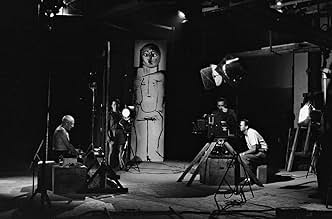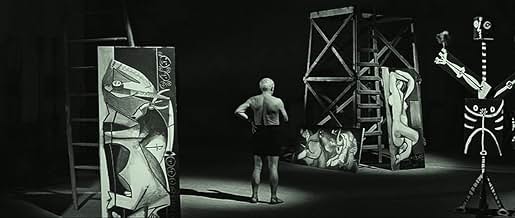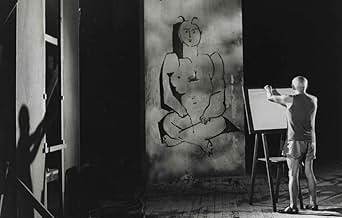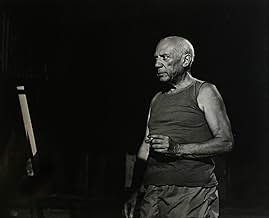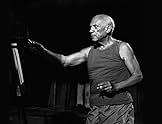AVALIAÇÃO DA IMDb
7,5/10
2,9 mil
SUA AVALIAÇÃO
Adicionar um enredo no seu idiomaA filmed record of Pablo Picasso painting numerous canvases for the camera, allowing us to see his creative process at work.A filmed record of Pablo Picasso painting numerous canvases for the camera, allowing us to see his creative process at work.A filmed record of Pablo Picasso painting numerous canvases for the camera, allowing us to see his creative process at work.
- Prêmios
- 1 vitória e 1 indicação no total
Pablo Picasso
- Self
- (as Picasso)
Henri-Georges Clouzot
- Self
- (não creditado)
Claude Renoir
- Self
- (não creditado)
Avaliações em destaque
I've always known that Pablo Picasso was one of the most prolific characters of the 20th century. I've also heard about how this film was made many times before, that is with the translucent screen between the camera and Picasso. At the beginning I thought that it was a bit slow and I remember wondering if I was in the midst of 2 hours of Picasso drawing picture after picture. And indeed it was, with a few breaks where we actually see and hear Picasso interact with the camera men. But, amazingly, once you get into watching the short drawing exercises, it becomes very captivating. You aren't sure what he's drawing, and then a line and a squiggle later it is a bull or a woman or whatever. The most mesmerizing part though, as another writer said, was when he was painting the beach scene and he kept painting over his work over and over again. What he was painting over was amazing and it made you wonder why he felt like it just didn't work.
If there was one word to describe this film for me, it would be "inspirational". And I think anyone who practices art or appreciates the process of art, can find this film enjoyable to watch. The film's title speaks for itself. We are engaged in an experimental documentary watching a prodigy at work and trying to unravel the magic of how it all happens. In the beginning there is a voice-over narrated introduction to the film, "Nobody knew what Rimbaud thought of when he wrote the poem "the drunk boat"." And then we realize that we are in for a real treat. Who would ever guess that the master of cubism would allow us to see his creative ideas at work? Most artists are very stubborn about this sort of thing, but then again most famous artists are also pretty ego-centric. The film places the camera behind a canvas that leaves the image transparent so that we can see the painting process without looking over the shoulder. There is a beautiful classical score along with this film and as the drawings progress, Picasso then takes on bigger challenges with paintings. The pacing is just right where the drawing process starts slow and then the strokes become faster with time-lapse photography. There is an amazing moment where the cameraman warns Picasso that he is about to run out of film. Picasso asks how many feet is left and calculates the timing of his painting and just at the last second, Picasso transforms the entire piece into something unexpected and radically different. We can see the spontaneity and playfulness in his work. The end is a mural shaped painting that evolves through many stages until Picasso says something like "its ruined. I have ruined the painting and yet at the same time, its improving." This is an indication of Picasso's fearless drive. When he paints, he is on fire. He works diligently for hours. Its fascinating to see little figures that he will paint over and over with more detail or more color. He wants to emphasize details that seem so ambiguous and its as if he's saying to the audience "look at this" "keep looking at this" "this is important." I first saw this film in the theater when I was about ten or twelve years old. I'm glad my family friends took me to see this. It has inspired me throughout the years. I saw the film again when I was twenty-four and it was just as I remembered it. After it was over, I did the same thing I did when I first saw the film; I pulled out a sketchbook and started drawing. This film is a real treat.
I received a VHS copy of this film from a friend who was going to trash it. My mother weaned me on trips to art galleries, spoon fed me stories of the personal lives of classic and modern masters, I worked in an art gallery liaisoning with the artists we represented and studied the psychology of creativity in college. This film had me riveted! I felt as though I was invited to eavesdrop, peek in on a great master at work. Every brush stroke was fascinating. I enjoyed the trip Picasso took me on as he started out painting one image and changed it into something else along the way. I enjoyed watching what appeared to be random brush strokes turn into a completed thought. This film helped me feel what it must be like to know when to stop... to know when you have finished a work... when you may have overworked it, when you may not have quite completed. It made me want to paint, not for others but for the simple pleasure one gets from the act of putting pigment on paper. It allowed me to feel free to create without fear of criticism. A must see for all artist and art lovers.
A-one-of-a-kind look at the artistic process, the unique art documentary captures the creativity itself. Two friends, the great painter and the great director, Pablo Picasso and Henri-George Clouzot decided to do what Goethe's Faust had dreamed about - to capture and to store forever the moment of beauty and inspiration. Picasso conceives, sketches, and paints twenty canvases before our eyes as the camera rolls. The film did not solve the mystery of Picasso who had said about himself, "When I was 9 years old, I could paint like Rafael; as an adult, all my life I tried to learn how to paint like a child" but it lets us to be the eye-witnesses of the amazing process - the birth of twenty works of art into existence. Twenty exiting moments the only Artist could live through are captured forever for us to enjoy again and again. Clouzot uses a specially designed transparent 'canvas' to provide an unobstructed view and different techniques including slow motion animation to let the main character, the invisible Picasso's brush speak for itself. The film is accompanied by exquisite music and gorgeous photography by Claude Renoir, grandson of impressionist painter Pierre-Auguste Renoir and nephew of Jean Renoir. The paintings created by Picasso in the film cannot be seen anywhere else. They were destroyed upon completion of the film. The French government has taken over the preservation of the original negative and has declared this truly unique and priceless documentary a national (and I would call it an international) treasure.
Criterion DVD also includes "Guernica", a short documentary directed in 1950 by Alain Resnais before any of his feature films. Picasso's "Guernica" is one of the most famous paintings of the 20th Century which was created by the artist in response to bombing and destroying the ancient Basque town of Guernica by German aviation on April 27 1937 during Spanish Civil War. The painting is a passionate protest against war as well as the fascinating work of art. Resnais' 13 minutes short film is based on paintings, drawings, and sculptures by Pablo Picasso from 1902 until 949 including "Guernica" and is set against the ode written by French lyrical poet Paul Éluard and recited by Jacques Pruvost and María Casarès. In his early short film, Resnais already uses his famous jump cuts and cross-fades. "Guernica" is a valuable feature which goes well together with the marvelous "The Mystery of Picasso" and adds to understanding one of the most prolific and mysterious Artists of the last century.
Criterion DVD also includes "Guernica", a short documentary directed in 1950 by Alain Resnais before any of his feature films. Picasso's "Guernica" is one of the most famous paintings of the 20th Century which was created by the artist in response to bombing and destroying the ancient Basque town of Guernica by German aviation on April 27 1937 during Spanish Civil War. The painting is a passionate protest against war as well as the fascinating work of art. Resnais' 13 minutes short film is based on paintings, drawings, and sculptures by Pablo Picasso from 1902 until 949 including "Guernica" and is set against the ode written by French lyrical poet Paul Éluard and recited by Jacques Pruvost and María Casarès. In his early short film, Resnais already uses his famous jump cuts and cross-fades. "Guernica" is a valuable feature which goes well together with the marvelous "The Mystery of Picasso" and adds to understanding one of the most prolific and mysterious Artists of the last century.
9sol-
A fascinating look at the creative process, filmed in a unique fashion, using a clever technique to capture Picasso's work as he is painting without his hand or his brush getting in the way. This method is actually shown and explained during a live action sequence in the middle. Although the film is mostly just a set of different Picasso paintings in action, interactions between the film's director and Picasso are added in, which not only decreases tedium from the at times monotonous paintwork, but it also makes it a whole lot more interesting, as it feels as if we are there with Clouzot and Picasso in a film studio. The material still becomes a tad repetitive and it tires before the film is over, but set to some great music and actually showing Picasso working through his creative process, this is remarkable, one-of-a-kind film-making and definitely worth checking out.
Você sabia?
- CuriosidadesPablo Picasso is shown creating 20 drawings and paintings from start to finish. He allegedly destroyed these artworks afterwards so they would exist only in the film.
- Citações
Pablo Picasso: I do not look for, I find!
Principais escolhas
Faça login para avaliar e ver a lista de recomendações personalizadas
- How long is The Mystery of Picasso?Fornecido pela Alexa
Detalhes
- Data de lançamento
- País de origem
- Idioma
- Também conhecido como
- The Mystery of Picasso
- Empresa de produção
- Consulte mais créditos da empresa na IMDbPro
Bilheteria
- Faturamento bruto nos EUA e Canadá
- US$ 267.836
- Fim de semana de estreia nos EUA e Canadá
- US$ 19.143
- 23 de fev. de 1986
- Tempo de duração
- 1 h 18 min(78 min)
- Cor
Contribua para esta página
Sugerir uma alteração ou adicionar conteúdo ausente


